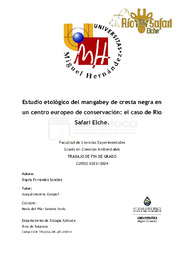Por favor, use este identificador para citar o enlazar este ítem:
https://hdl.handle.net/11000/33294Registro completo de metadatos
| Campo DC | Valor | Lengua/Idioma |
|---|---|---|
| dc.contributor.advisor | Moreno Compañ, Joaquin | - |
| dc.contributor.advisor | Soriano Navio, Maria del Pilar | - |
| dc.contributor.author | Fernández Sánchez, Ángela | - |
| dc.contributor.other | Departamentos de la UMH::Biología Aplicada | es_ES |
| dc.date.accessioned | 2024-09-25T11:45:38Z | - |
| dc.date.available | 2024-09-25T11:45:38Z | - |
| dc.date.created | 2024-06 | - |
| dc.identifier.uri | https://hdl.handle.net/11000/33294 | - |
| dc.description.abstract | El enriquecimiento ambiental para la mejora del bienestar en animales cautivos es una actividad altamente utilizada y muy estudiada por sus beneficios. Es importante tener en cuenta que, para mantener a una especie sana y viable para futuras reintroducciones, es fundamental asegurar su bienestar. Se ha demostrado que el enriquecimiento ambiental favorece el aprendizaje de comportamientos naturales y reduce la tasa de comportamiento estereotipado, haciendo que las reintroducciones sean más efectivas. En este estudio, se ha comparado el comportamiento de una familia de mangabeys de cresta negra (Lophocebus aterrimus) en situaciones basales (sin enriquecimiento) y situaciones con nuevos enriquecimientos. Los cambios en el comportamiento demostraron como la incorporación de enriquecimientos a la rutina de estos individuos los volvió más activos, tanto mental como físicamente, y redujo la aparición de comportamientos estereotipados, mejorando su bienestar. | es_ES |
| dc.description.abstract | Environmental enrichment for the improvement of welfare in captive animals is a highly utilized and well-studied activity due to its benefits. It is important to consider that in order to maintain a species healthy and viable for future reintroductions, ensuring their welfare is fundamental. It has been demonstrated that environmental enrichment promotes the learning of natural behaviours and reduces the rate of stereotypic behaviours, making reintroductions more effective. In this study, the behaviour of a family of black-crested mangabeys (Lophocebus aterrimus) was compared in baseline situations (without enrichment) and situations with new enrichments. The changes in behaviour demonstrated how incorporating enrichment into the routine of these individuals made them more active, both mentally and physically, and reduced the occurrence of stereotypic behaviours, improving their welfare. | es_ES |
| dc.format | application/pdf | es_ES |
| dc.format.extent | 38 | es_ES |
| dc.language.iso | spa | es_ES |
| dc.publisher | Universidad Miguel Hernández de Elche | es_ES |
| dc.rights | info:eu-repo/semantics/openAccess | es_ES |
| dc.rights.uri | http://creativecommons.org/licenses/by-nc-nd/4.0/ | * |
| dc.subject | conservación ex situ | es_ES |
| dc.subject | enriquecimiento | es_ES |
| dc.subject | etología | es_ES |
| dc.subject | mangabey de cresta negra | es_ES |
| dc.subject | ex situ conservation | es_ES |
| dc.subject | enrichment | es_ES |
| dc.subject | ethology | es_ES |
| dc.subject | black-crested mangabey | es_ES |
| dc.subject.classification | Botánica | es_ES |
| dc.subject.other | CDU::5 - Ciencias puras y naturales::57 - Biología::574 - Ecología general y biodiversidad | es_ES |
| dc.title | Estudio etológico del mangabey de cresta negra en un centro europeo de conservación: el caso de Río Safari Elche | es_ES |
| dc.type | info:eu-repo/semantics/bachelorThesis | es_ES |

Ver/Abrir:
TFG-Fernández Sánchez, Ángela.pdf
1,72 MB
Adobe PDF
Compartir:
 La licencia se describe como: Atribución-NonComercial-NoDerivada 4.0 Internacional.
La licencia se describe como: Atribución-NonComercial-NoDerivada 4.0 Internacional.
.png)